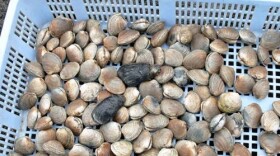Since at least the week of Aug. 15 an advisory has been in effect for toxic shellfish sampled across various beaches around Kodiak. Then on Friday, Oct. 10, Kodiak Area Native Association’s Environmental team relaxed the advisory but cautioned against eating untested shellfish in the organization's latest phytoplankton update.
KANA is not a regulatory agency and the consumption of wild shellfish in Alaska is considered ‘eat at your own risk’.
For the past two consecutive months, the organization has found elevated toxin levels in shellfish like blue mussels at public sites such as Mission Beach and White Sands beach. KANA has been sampling shellfish from at least three different sites every week and monitoring for the toxins that cause Paralytic Shellfish Poisoning or PSP. The organization also conducted a testing blitz in response to high toxin levels it found at routine monitoring sites.
"For example, we saw on Aug. 20 at KA Camp (out the road) we had blue mussels come back at 26 micrograms of toxin," Andie Wall, the environmental programs supervisor with KANA, said. "Then two weeks later, on Sept. 5, KA Camp was at 962 micrograms of toxin."
Wall said this result was the second-highest level of toxin KANA Environmental has ever seen.
"The locations like Frye Point or “Sometimes Island”, we have been testing for close to two years, and it has never gone above the limit, but on Sept. 5, it reached 126," she said. "It went back down from the last blitz on Oct. 7 to 17. So, you can see the variability and scale of change we are starting to track."
When the toxins in shellfish are above the Food and Drug Administration’s regulatory limit of 80 micrograms per 100 grams, then the toxic shellfish can potentially cause PSP in humans who eat them.
Symptoms can include tingling in the lips and fingertips, numbing of the arms and legs, nausea, difficulty breathing and even death. Anyone with these symptoms should seek immediate medical care, or call 911 or their local clinic immediately.
Julie Matweyou, the marine advisory program agent with the Alaska Sea Grant in Kodiak, said in an email that, "Blue mussels are used as a sentinel species to help monitoring toxic phytoplankton blooms, and closely reflect conditions in the ocean. While the phytoplankton bloom is likely winding down and blue mussels returning to below regulatory level, the toxins are not released as readily in other bivalves including popularly harvested clams."
Despite the toxin advisory being relaxed, KANA encourages caution and recommends shellfish harvesters submit a sample of their shellfish to the organization for free testing through the harvest and hold program.
For more information and to see the latest toxin levels from last week’s sampled shellfish, go online to KANA Environmental’s website.
Editor's Note: This story has been updated to include additional information from KANA Environmental and Alaska Sea Grant in Kodiak. The headline of this story was also changed to show that the advisory was relaxed instead of lifted.




